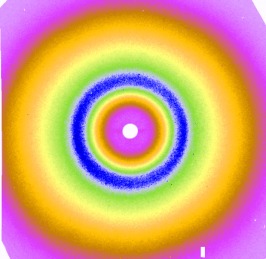Use of light to study nanoparticles self assembly
We use UV/Vis spectrometry and X-ray scattering tecniques (SAXS) to study nanoparticles super-structures. The structural study of the material is the first step before understanding its overall properties and considering applications. SAXS is an experimental technique used to study the structural properties of materials and gives information on the size and orientation of the nanoparticles, their arrangement, the characteristic interdistances and the possible long-range organization. In a scattering experiment, ordered phases give diffraction signals that are called Bragg peaks. Analysis of such signals requires adapting standard methods of crystallography to the nanoscale, as the relevant length scale is much larger than the atomic scale. UV/Vis spectrometry is used complementary to measure the collective optical properties. Both techniques can be used in situ to study self assembly's pathways.
